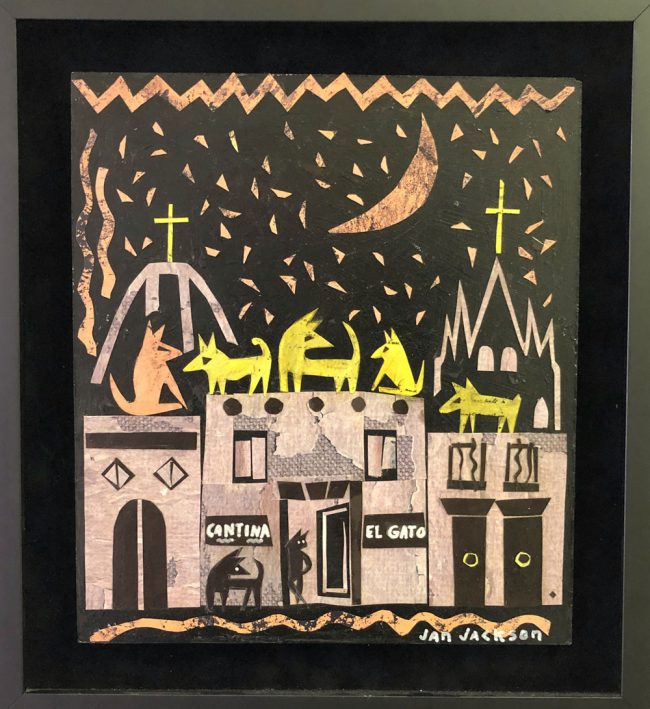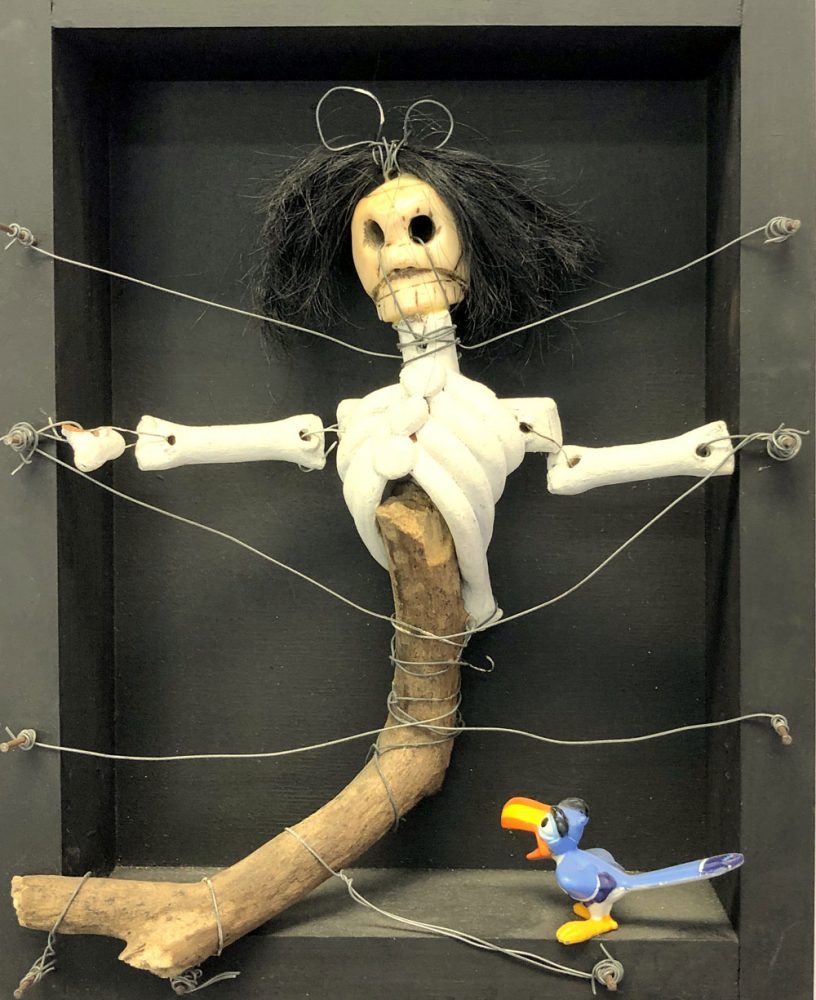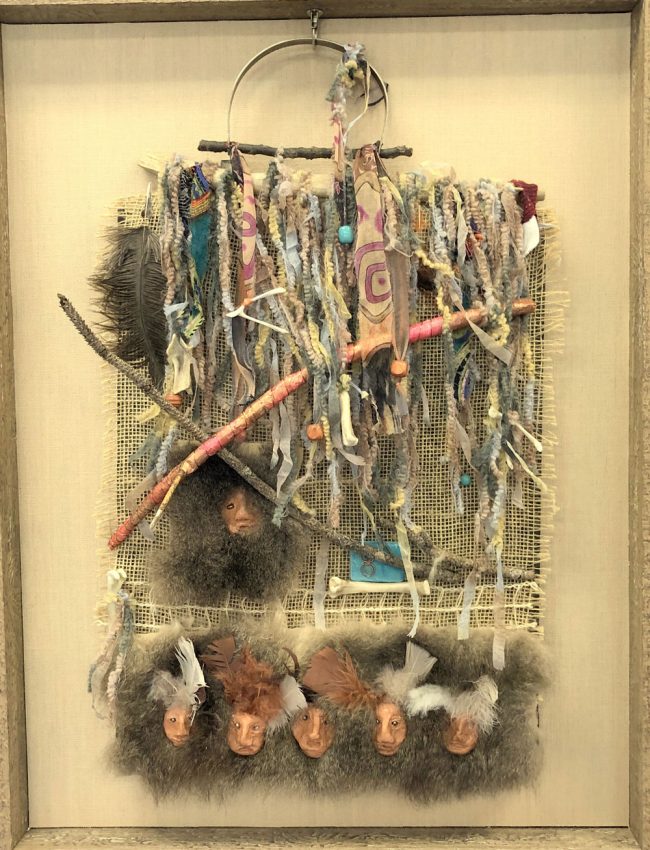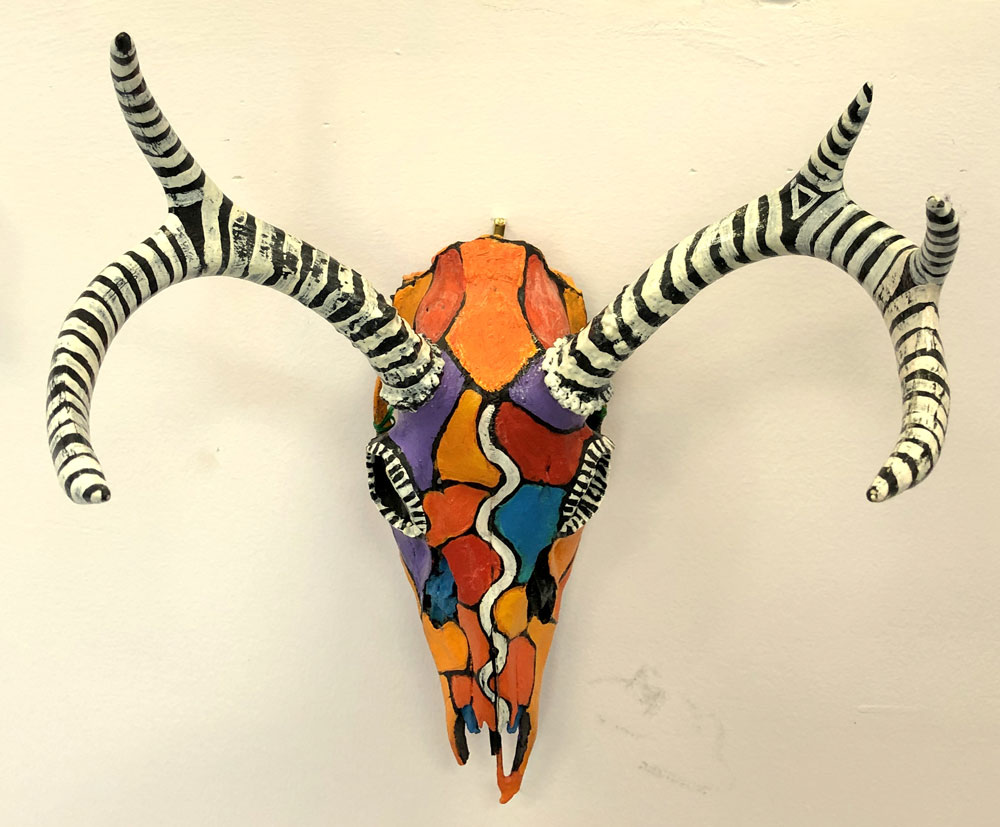
Walk into Galleria d’Arte in Palm Coast and you’ll be greeted by “Monkey Mask,” an arcane, three-dimensional artwork dangling by nylon string in the front window of the strip-mall art gallery. With its bulbous, tapered eye holes, weird antlers and patterned colors, the piece by Jan Jackson, the Gargiulo Art Foundation’s Flagler County Artist of the Year for 2020, looks like a cross between an extraterrestrial and some tribal shaman.
Jackson fashioned the mask, which is part of a celebratory, retrospective exhibition of her work at the gallery through April 27, from a monkey pelvis – one “evidently” killed by her ex-husband, a big-game hunter, she says.
“He sent me the pelvis,” says Jackson, who notes, with self-questioning hesitation, that she remains friends with her ex. “I don’t know what he did with the rest of it. It’s probably stuffed in his house.”
That monkey pelvis has kindred company at Jackson’s exhibition. Along with her whimsical oil and acrylic paintings of dogs, and her pastels of animals inspired by the Mola fabric art of the Kuna people of Panama, bones abound in Jackson’s art: skulls of a bear, deer and wildebeest, and enough chicken bones to arouse the curiosity of a Santeria priestess.
“People go ‘Why are you so interested in skeletons and bones?’,” says Jackson, a Palm Coast resident who grew up in Michigan and earned degrees in fine art, art history and elementary education from Wayne State University.
“It starts way, way back,” Jackson says with a laugh. “I think my interest came after my father died before I was 1-year-old. I never knew him. I was an avid reader — I read before kindergarten somehow — and I was really interested in how I could get in contact with my dad. So as a kid I was reading about weird poltergeist things, ESP and stuff like that. I’m always attracted to literature and movies that are a little dark, that may have some connection to another world.”
Like almost every artist or creator, Jackson is a bit mystified by the methods of her muse, especially when it drives her to conjure art from skulls and bones – a predilection that didn’t manifest in her art until she was in her 60s.
Yes, the death of her father played a role, but as the 81-year-old artist rummages through her psyche, she also notes the shock she still experiences from her first husband’s hunting expeditions: from his picking off the placid deer that fed near the family’s wilderness lodge in Michigan, to killing bear and moose in Canada, to taking down an elephant in Africa, then helping his third wife do the same.
“It’s still so shocking to me that they did that,” Jackson says.
As word spread that Jackson was making art from animal bones, her ex would send her a monkey pelvis or wildebeest skull, and “a friend of mine who kept finding things in his yard gave me a possum head,” she says. “In my daughter’s driveway there was this squashed bird, a car ran over it, and it was kind of dried up so I took it. My daughter’s a doctor, so of course she had a fit: ‘What are you going to do with that?’ I go, ‘I don’t know but I need to have it.’ Now it has little jewels on it – it’s called ‘The Early Jeweled Bird Gets the Agave Worm.’ When I last looked at it, the worm had disintegrated.”
So, does Jackson believe that her bone- or skull-infused works such as “Ritual,” “Desert Zebra I” and “Desert Zebra II” (fashioned from Michigan deer skulls), “Treasures of the Painted Bear” and “Honoring the African Wildebeest” are, well, honoring those slain animals by incorporating them into her art?
“Yes, absolutely, because if they are just laying somewhere or they are in somebody’s attic, eventually they are just going to turn to dust,” she says.
She hesitates, then confesses with a sardonic laugh: “Then it kind of transferred to chickens and lamb, things that we eat. So, I don’t know that I’m honoring the things that we eat. I guess it’s sort of an honor – what do we do with these bones? I think it’s some kind of spiritual connection — all living things are connected, and to let them go out of existence, it just seems like we should somehow preserve them.”

Still, the ways and motivations of her muse are elusive.
“I’ve had to figure it out myself: Where is this coming from? Is this a dark side?” she says. “I used to think I had a dark side, but now I don’t think so.”
Encounter Jackson in person and any such talk of a dark side is negated by her pixie-ish demeanor – blonde pageboy hairstyle, bright smile, laughter that frequently punctuates her conversation and that moves effortlessly from graceful to sardonic to light-hearted.
Indeed, whimsy and playful ebullience abound in Jackson’s art.
Yes, look closely at “Black Dog Growls,” an acrylic and mixed media work, and one can detect ghostly blue, ominous wolves lurking in one corner, a string of tiny, painted animal skeletons along the bottom, and a scrap of a book or magazine page pasted smack-dab in the center with text that reads “The tragedy of human existe . . . .”
Yet the happy-go-lucky mood of the Picasso-esque dog, his mirror image and other nearby canines is dictated by the bright red letters splayed on the canvas: “Life Doesn’t Frighten Him.” (The 25×36 work sells for $1,500, and is also available as the official exhibition poster for $35.)
The blue dog of the acrylic work “Keep Off the Grass” growls amid industrial block lettering that reads “I’m Not Your Son.” “Cantina El Gato,” a collage, depicts dogs hanging outside, and atop, a cantina that’s only open to cats.

“Monkey Business,” an acrylic rendered in Jackson’s beloved, colorful Mola style, shows an ecstatic monkey amid three smiling parrots, while a menagerie of smaller, childlike animal portraits surrounds them.
“Mola is fabric art done by the Kuna Indians in Panama — they live on this little isthmus,” Jackson says. “It’s wearable blouses, color upon color of these little fantastic animals or things that are important in their culture — religious, social or whatever. I traveled extensively in South America and Mexico and collected them for years.”
Her Mola work sprang from “a desire not to be a look-alike,” she says. “I didn’t want to copy a watercolorist, so I developed that style. There are a lot of little markings like stitching marks. I think stitching when I do them.”
As for those animal bones and skulls, Romanian-born scholar Mircea Eliade writes about the magical properties of skeletons in his exhaustive, definitive 1951 book “Shamanism: Archaic Techniques of Ecstasy”: “Among hunting peoples bones represent the final source of life, both human and animal, the source from which the species is reconstituted at will. This is why the bones of game are not broken, but carefully gathered up and disposed of according to custom, that is, buried, placed on platforms or in trees, thrown into the sea, and so on.”
While Eliade fails to note that bones are the longest-surviving parts of a human or animal body, he goes on to note that ancient shamanic societies believed, for both humans and animals, that “the ‘soul’ is presumed to reside in the bones and hence the resurrection of the individual from its bones can be expected.”
Jackson’s artistic skeletal resurrections include such previously cited works as “Ritual” and “Treasures of the Painted Bear” – collages whose mediums she coyly, or perhaps timidly, lists as “mixed,” and whose tableaus of bones, feathers, fabric and wood would resonate with the Paleolithic shamans who painted animals on the walls of Lascaux Cave in France 17,000 years ago.
Closer to that “dark side” is the small but potent “Night Terror,” which someone outside of the practice of Haitian Vodou or Santeria might stereotype as some sort of voodoo doll.

“I had a desire to make a doll out of bones,” Jackson says. “I started researching and there are some cultures that actually make bone dolls for their children. I never accomplished making a bone doll so it went sometimes into bone figures.”
The title of Jackson’s work points away from Vodou or Santeria. Night terrors or sleep terrors, which are different from nightmares, are a clinically recognized disorder in which a person experiences panic, dread or intense fear while asleep, and can even lead someone to scream or flail about without waking up.
But Jackson’s bone-infused piece also points to another phenomenon that scholar David J. Hufford chronicles in his book “The Terror That Comes in the Night: An Experience-Centered Study of Supernatural Assault Traditions.” Hufford explores people’s surprisingly common, frightful encounters with the “Night Hag” or “Old Hag.” While such incidents often are associated with the clinically documented condition of sleep paralysis, “Hag” encounters have the added dimension that sufferers report feeling paralyzed and suffocated by a malign supernatural entity sitting on their chest.
Lest one become too mired in the faintly sinister face of her “Night Terror” figure, the collage also includes a small, colorful, almost cartoonish figurine of a parrot, which gazes bemusedly at the bone woman.
Some of Jackson’s bone works sport a more overt aesthetic cheerfulness. Her “Desert Zebra” pair and “Honoring the African Wildebeest” are painted animal skulls that incorporate elements of her colorful Mola style – thus, akin to the spirit-world practices of Eliade’s shamans, these animal remains are resurrected into artworks that possess a strange, incongruous but palpable joie de vivre.
While the seeds of Jackson’s fascination with bones and skulls were being planted in her childhood, as she was reading poltergeist stuff and yearning to speak to her dead father, she was being raised by her Greek grandparents in Michigan.
“My mother was kind of like a Greek princess and she was only 20 — she was a kid,” Jackson says. “I had a mother who was always in love with her dead husband, although she did marry again. I think she was always proud of getting sick and trying to die, or something. I have a painting titled ‘Then and Now’ in the current show — I didn’t realize until after it was finished that the face is my mother’s, and she has her arm around a skeleton.
“So really my grandparents raised me. They had a restaurant next door to where we lived, probably the first drive-in restaurant in the state, with wonderful Greek food — spits in the window with pork and lamb and beef. My grandparents were usually at the restaurant during the day and I was pretty free as a kid. I could help my grandfather or do whatever I wanted to do.”
With a sardonic laugh, she adds: “I remember sometime standing at the window and crying – ‘poor little girl had a dead father, never knew her father,’ you know.”
After earning her art, art history and elementary education degrees from Wayne State University, Jackson taught in a “progressive school” in Chicago for 20 years, using an innovative program that emphasized writing composition and the arts across the curriculum “whenever it was appropriate,” she says.
She divorced her first husband after 10 years of marriage, then married her current husband Leigh, who owned three car dealerships in the Chicago area before selling them to go into consulting.
Jackson retired from teaching “so I could go back to my art,” she says. During the couple’s 52 years together, they have lived in Scottsdale, Arizona; Dayton, Ohio; and Albuquerque, N.M. Jackson ran her own art gallery in Albuquerque before the Great Recession tanked it, and she and her husband, who was attracted by the lack of a state income tax in Florida, moved to the Sunshine State in 2013.

Since moving to Palm Coast, Jackson has stayed busy with arts pursuits apart from creating her own work. Before the pandemic shut-down, she taught pastel painting at the Flagler County Art League. She participated in the Turtle Trail, a public community sculpture project by the Palm Coast Arts Foundation, in which area artists paint large fiberglass loggerhead turtles purchased by sponsors. The turtles are then placed throughout Flagler County at the discretion of the sponsor. Jackson’s turtle, named Vincent and painted in the style of van Gogh, is located at the Palm Coast Community Center, 305 Palm Coast Parkway, N.E.
Since mid-2019 Jackson has been the curator at Grand Gallery, an art space with frequently changing exhibitions housed in Grand Living Reality at 2298 Colbert Lane in Palm Coast. The Palm Coast Arts Foundation recently partnered with Grand Gallery, Jackson said. In return for PCAF helping the gallery with publicity, PCAF will receive the 20 percent commission the gallery collects from its art sales.
Tom Gargiulo, who co-founded the Gargiulo Art Foundation with his partner Arlene Volpe, says Jackson is its 2020 Artist of the Year “for two main reasons. One, she is a very good artist. We went to Jan’s home and it was just overwhelming. There was work we had never seen before publicly. Right away I could see us having a retrospective exhibit of her work.
“There are a lot of things I saw in Jan’s work that I was trying to get other people to do. You don’t have to draw or paint. She uses some bones and found objects, a piece of driftwood she picked up, and she puts them together.
“And two, she does a lot for the art community. She curates shows at Grand Gallery. She’s very supportive of artists — she assists them and helps them hang their shows. She’s active in the Flagler County Art League.”
The Gargiulo Art Foundation’s four nominees for its 2020 Flagler County Artist of the Year also included Barb Forristall Scapin, Bob Teller and Christine Broussard. The four artists were featured in an exhibition in February at Galleria d’Arte.
“The competition was there to see – they are talented people,” Jackson says. “It was a thrill to get this award. Not that I was ever trying to get it, but this is a culmination of things I’ve been doing in the art community.”
Jackson believes her work “is really surreal.” That’s reflected in her artist statement that accompanies her exhibit at Galleria d’Arte, which reads: “ ‘Alice opened the door and looked down into a small passage not larger than a rat hole, into the loveliest garden she ever saw. How she longed to get out of that dark hall among those beds of bright flowers and cool fountains. But she could not even get her head through the door.’ Like Lewis Carroll’s Alice does eventually, I find a way to squeeze through that small opening and enter a world with no boundaries. There I am free to explore, create and grow.”
Galleria d’Arte is at 230-231 St. Joe Plaza Dr, Palm Coast, Florida. Hours are 11 a.m.-4 p.m. Monday and Wednesday, 10 a.m.-5 p.m. Tuesday, Thursday and Saturday, 11-6 p.m. Friday and noon-5 p.m. Sunday. Information: 386-0585-4191 or galleriadeart.com.
![]()






























Jan Jackson says
This article, Rolling the Bones, is a gambling term having no connection to me or my art. The article itself is demeaning and does not represent me or my life’s work. I trusted the writer to write an article that truly represented who I am and the seriousness of my art. He did teach me a lesson. Don’t be so naive and trusting that my best interests are at heart. This writer was not my friend. I believe his intentions were mean-spirited and not in the least humorous.
The Garguilo Art Foundation and Galleria d’Arte will be disappointed in my portrayal. I am a serious, competent artist and not the dumb , flippant blonde portrayed. I would not otherwise have been selected for the honor of Artist of the Year. This is a serious award , and I expect to be treated seriously. I work timelessly to promote and support the artists of our community, and I believe this portrayal is not the person/artist who they know.
Was this article not edited? I demand an apology from the writer , editor and publisher.
Pierre Tristam says
As the editor of this piece I’m at a loss to understand what in this lavish profile Ms. Jackson finds “demeaning” or unserious. Our culture writer, the very best in the region bar none, has three decades’ experience covering the arts. No, he was not Ms. Jackson’s friend: he would not have been assigned the story if he were. But his profile, developed with care over a long period, provides critical interpretations that match or exceed the vividness of Jackson’s work, the tone is either admiring or affectionate, the analysis, to me the most compelling part of the profile, balances critical perspectives with scholarship, providing context we rarely get anymore from fly-by-night articles on art that tend to rewrite witless PR flackers’ blurbs and pose as journalism. Clearly and thankfully, that’s not the case here. FlaglerLive is fortunate to have cultural journalism of this quality. Ms. Jackson’s “demand” for an apology is the unserious suggestion I see here. The only thing owed the writer is thanks and appreciation for once again honoring the Garguilo Art Foundation’s Artist of the Year with a profile to match.
JimB says
I found the article very well written and informative with nothing that could be construed as flippant or insulting. Quite frankly, what I found flippant and insulting was the “art”.
Mindy Oksenhorn says
I’ve had the pleasure of having Jan Jackson as an instructor for soft pastels. She introduced me to a medium that helped me connect to art that was missing in the previous mediums that I painted in. Jan encouraged me and others to develop our own style and technique. Jan’s style is very unique and imaginative. I find Jan’s art not to be one that displays evil or demonic symbolism but one of creative visualization. Jan Jackson earned and was recognized appropriately as The Gargiulo Art Foundation’s 2020 Flagler County Artist of the Year.
Steve G says
Art like beauty is in the eye of the beholder. Jan Jackson is an accomplished, versatile and daring artist. Unlike most artists, she does not confine herself to a single genre or medium, but allows her talent and imagination free rein.
Years ago when we both happened to reside in New Mexico, I acquired one of her works and proudly display it in my home. When people visit, Ms. Jackson’s work usually draws the most attention and comment. It happens to be a whimsical pastel featuring two alpha cats, a church, a windmill, several dogs fearfully avoiding the cats, and prominently overseeing the entire scene is a strikingly blue moon.
I confess to not being an art expert or critic. But one of many things I find appealing and also unusual about Ms. Jackson’s art is that she not only endeavors to convey to the viewer the product of her imagination, but she invites, indeed provokes, the viewer to engage his or her own imagination to determine what her art says to them.
A still life is a still life; an Impressionist landscape is a landscape, but a Jan Jackson piece often evokes multiple interpretations.
I have followed her work over the years and have no doubt that she is most deserving of her recent award as PCAF Artist of the Year.
Sheila Zinkerman says
As an artist, one of the pleasures I look forward to is reading articles in FlaglerLive’s Culture section. It was no different when, on 03/19/2021, I read “Rolling the Bones: Jan Jackson Is Flagler County’s Artist of the Year.” The title caught my eye so I opened the article. As I read, it was obvious to me that the culture writer of the article had an acute sense of observation when describing and analyzing Ms. Jackson’s art. Furthermore, I admired how the writer also engaged the artist with questions in a meaningful yet curious way which elicited comments from Ms. Jackson that both held my attention and aroused my interest in her art. It is for this reason that I believe that the culture writer did what any exceptionally good art and culture writer does; made Jan Jackson and her art accessible to a wider audience of FlaglerLive readers like me. Congratulations to the Garguilo Foundation and Jan Jackson, Artist of the Year.
Suzanne O’Meally says
I’ve just finished “Rolling the Bones” and I question what this gambling reference has to do with Jan Jackson, artist of the year or her retrospective. Nothing! I have several pieces of Jan’s amazing artwork in my home, have taken classes from her and call her friend. This reads more like an article in Psychology Today than a local culture piece, with the writer psycho analyzing the artist and her work. I did appreciate his explanation of Jan’s take on mole and how she interpreted it into her own style. My opinion but art style is what the writer should be writing about.
Kathleen Gaffey says
I would first like to Congratulate Jan on a well deserving award of being selected as The Flagler County 2020 artist of the year.
Her work is incredible. I have 3 of her pieces hanging in my home and really enjoy them. I also took a pastel class that gave me another dimension to my own art. I felt this article should have focused more on her beautiful & intriguing pastels and not on what her past work with bones and what they “may”represent. I was lost on the lengthy narrative.
I hope everyone gets to visit her exhibit at
Galleria d’Arte in St Joe’s Plaza to interpret her art yourself & not how someone tells us how to interpret it. You will not be disappointed in her unique style.